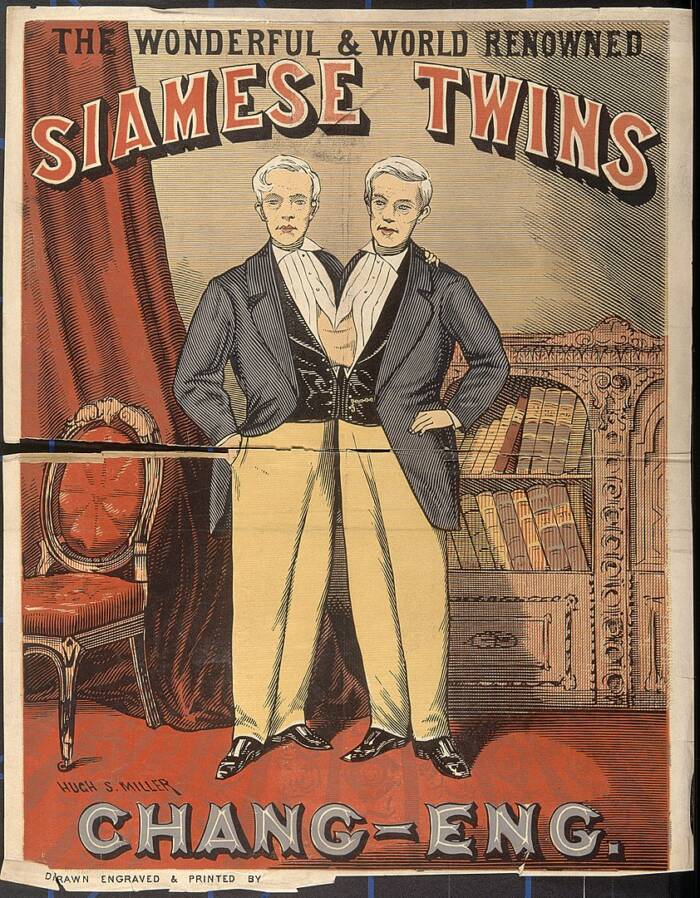In the early 1900s, Jean Libbera performed in sideshows with his brother Jacques, a parasitic twin who was attached to Jean at the chest and stomach.

Public domainJean and Jacques Libbera traveled across Europe and the United States in various “freak shows.”
In the early 20th century, audiences at circuses and sideshows all over the world were captivated by Jean Libbera, the “Double-Bodied Man,” who had a small parasitic twin named Jacques growing out of his torso.
Jacques had two arms, two legs, and a partially formed head embedded in Jean’s stomach, but reportedly depended entirely on Jean’s bodily functions to survive. Consequently, Jean had the burden of carrying his twin brother around with him his entire life.
Still, despite his condition, Jean managed to lead a fairly normal existence. He got married, had four children, and lived to be about 50 years old.
But with few records of Jean Libbera’s life outside of sideshow advertisements, much of his story is shrouded in mystery.
The Double-Bodied Man Is Born

Find A GraveX-rays allegedly revealed that Jacques’ semi-formed head was embedded in Jean’s stomach and had a circumference of only six inches.
Jean Libbera was born in Rome in 1884 with a parasitic twin attached to his abdomen. He was one of 13 children, another of whom also had a parasitic twin but did not survive past infancy.
Libbera’s twin, Jacques, was a vestigial parasite. This condition occurs when an embryo only partially separates into twins and the two sides develop asymmetrically in utero, resulting in the smaller twin being attached to the larger, more developed one.
Parasitic twins like Jacques are a type of conjoined twin. According to the Cleveland Clinic, conjoined twins are incredibly rare, affecting only about one in 50,000 pregnancies worldwide. Parasitic twins, meanwhile, reportedly account for around 10 percent of conjoined twins and affect less than one in a million births worldwide.
Because vestigial twins almost always die in the womb, today, doctors typically remove the parasitic twin after birth to prevent the surviving twin from experiencing medical issues.
But in the late 19th and early 20th centuries, people with vestigial parasites would often perform in circuses and sideshows. And that’s exactly what Jean Libbera did.
The Life Of Jean (And Jacques) Libbera

Public domainJean Libbera had a parasitic twin that reportedly depended entirely on his bodily functions to survive.
Jean Libbera grew up to be a traveling “freak show” performer known as the “Double-Bodied Man,” showing off his small twin to curious audiences at circuses and sideshows all over the world. Often, the brothers would wear matching suits during performances.
“I don’t know if people really fainted when they saw Jean Libbera,” said “freak show” photographer Diane Arbus, as reported in Rachel Adams’ book Sideshow U.S.A.: Freaks and the American Cultural Imagination. “He looked a bit rueful in a poster on the far wall, standing in a tuxedo sweetly holding the hands of his vestigial twin who grew, head inwards, sticking out of his abdomen and wore, the twin did, little patent leather shoes and a diaper to keep him from wetting his pants.”
Jacques had two small arms, two hands, two legs, and two feet. While parasitic twins typically lack consciousness, according to some reports, Jacques was alive and could even move — though he depended on Jean to survive. Jean and Jacques quite literally shared everything, including circulatory and nervous systems.
As Marc Hartzman wrote in his book American Sideshow, pamphlets distributed at Jean Libbera’s performances proclaimed that a “very thorough and complete” X-ray had shown that Jacques’ partially formed head was embedded in Jean’s stomach and measured only six inches in circumference.
Still, with few records of Jean-Jacques’ life, it’s hard to know what exactly was true, and what was exaggerated in the name of show business.
When he wasn’t onstage, Jean managed to live a relatively normal life, supposedly covering Jacques with a cloak whenever he went outside. He also found a wife, with whom he had four healthy children.
Eventually, Jean Libbera retired from show business and moved back to Italy, where he died sometime between 1934 and 1936 at the age of about 50.
Other Conjoined Twins In The Circus
While Jean Libbera and his brother Jacques were a rare case, they certainly were not the only conjoined twins to perform in European and American circus shows in the late 19th and early 20th centuries.
One of the first documented cases of conjoined twins, and arguably the most well-known, was that of the Bunker twins, Chang and Eng. In fact, the term “Siamese twins” was originally coined in reference to the brothers, who were born in Siam (now known as Thailand) in 1811.
The two men, both perfectly healthy from birth, were connected at the sternum and waist by just a few inches of tissue.

Wellcome Library/Wikimedia CommonsThe term “Siamese twins” came from Chang and Eng Bunker, conjoined twins from Siam (modern-day Thailand).
In 1829, the Bunkers left Siam with a British sponsor to tour with sideshows and circuses around the world. They even had a stint in P.T. Barnum’s American Museum.
The Bunker brothers eventually settled down in North Carolina, married a pair of sisters, and had 21 children between them.
One of the most tragic cases involving conjoined twins in the early circus days was that of the Hilton twins, Daisy and Violet. The two girls, born in England in 1908, were fused together at the hips and pelvis. Their mother was unmarried, and shortly after their birth, their mother’s employer Mary Hilton effectively bought the twins with the intention of putting them on display for entertainment.

Wikimedia CommonsDaisy and Violet Hilton were another well-known example of conjoined twins in the American circus circuit in the early 20th century.
Daisy and Violet began performing and touring at the young age of three years old under the strict care of Mary Hilton. The twins were essentially enslaved by Mary and her husband, and later by Mary’s daughter after her death. They were forced to work long hours without pay, and faced beatings if they disobeyed their captors.
But in 1931, the sisters sued their managers and won their emancipation. They went on to perform in vaudeville and burlesque shows as an independent act.
Their story has since inspired a number of movies, as well as a Broadway musical, Side Show, which premiered in New York in 1997 and was nominated for multiple Tony awards.
After reading the incredible story of Jean Libbera, the Double-Bodied Man, read about Frank Lentini, a sideshow performer who had three legs, 16 fingers, and two penises. Then, discover the story of Martin Laurello, the “Human Owl” who could turn his head completely backward.





